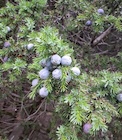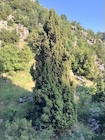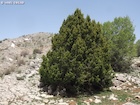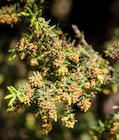
Foliage and mature seed cones on a plant in habitat, Greece. iNaturalist observation 194019536 [Hans Reip, 2023.12.15].

A tree in habitat on Mount Lebanon. iNaturalist observation 220835622 [Ramez Atallah, 2024.06.05].

A tree in habitat, Mount Hermon, Israel. iNaturalist observation 115913509 [Yael Orgad, 2022.04.19].

Ripe pollen cones on a tree in habitat, Lebanon. iNaturalist observation 71116615 [Akkar Trail, 2020.05.11].
See also iNaturalist observation 259743170 which provides anatomical detail on foliage, buds, seed cones, bark, etc.

Conservation Status

Juniperus drupacea
Labill. 1791
Common names
Syrian juniper (Farjon 2005).
Taxonomic notes
Syn: Arceuthos drupacea (Labill.) Antoine et Kotschy (Vidakovic 1991). The sole member of Juniperus sect. Caryocedrus Endlicher; this section is allied to sect. Juniperus but differs in the larger pedunculate cones with fused seeds, and broader leaves.
Description
A tree 10-20 (40) m high. Crown conic. Bark rather thick, brown-gray, longitudinally fibrous. Branches spreading or ascending. Branchlets three-sided, with prominent ridges, one-year shoots greenish and two-year ones brown. Leaves needle-like, in whorls of 3, horizontally spreading, tough, 15-25 mm long, 2.5-3.5(-4) mm wide, broadest in the lower third, upper surface slightly chanelled and with 2 white stomata bands; lower surface green, occasionally glaucous (Karaca 1994). Dioecious plant. Fruit globose to ovate, the largest in the genus, 15-25 mm in diameter, ripening in the second year, edible, composed of 6-9 fleshy scales, initially greenish with a waxy bloom and when ripe turning blue-violet to brown and pruinose; axillary on a 5-8 mm peduncle, the peduncle with short (3-4 mm) leaves. Seeds 3 to a fruit, fused together in a hard nut, 10-12 mm long (Vidakovic 1991, Frankis, M.P., pers. comm. 1999.02.05). See García Esteban et al. (2004) for a detailed characterization of the wood anatomy.
Distribution and Ecology
Greece, Turkey, Syria, Lebanon, Israel. Most extensive in the Toros Daglari (Cilician Taurus mountains) of S Turkey extending into N Syria; the remaining populations are disjunct and include Mt Parnonas, SE Peleponnisos, Greece (rare); Golan Heights (Israel/Syria); and in Lebanon. Also in coastal forests and maquis (Vidakovic 1991, Vladimir Dinets, e-mails 1998.01.12, Farjon 2005). "It occurs either in small groups or solitary in stands composed of Cedrus libani, Abies cilicica, Pinus nigra, Juniperus foetidissima and Juniperus excelsa. Optimal elevation for this species is between 600 and 1500 m. It succeeds on lime terrains" (Vidakovic 1991). Hardy to Zone 7 (cold hardiness limit between -17.7°C and -12.2°C) (Bannister and Neuner 2001).
Remarkable Specimens
The largest tree on record is about 40 m tall and 110 cm dbh, at Kasimdede cemetery, Kalekaya village (980 m altitude), Hartlap district, Kahramanmaras, Turkey; it grows among a group of equally large Cedrus libani: "[A]mong those competing individuals, there was one which made us excited and forget the cedars: a juniper with a girth of at least 350 cm and a height of 40 m like cedars. . . . I hugged and caressed it." (Karaca 1994). If the height is accurate, this could be the tallest juniper.
Ethnobotany
Observations
Remarks
The epithet drupacea means "stony fruits" and refers to the seeds.
Citations
Karaca, H. 1994. Monumental trees of Turkey: 6. Juniperus drupacea. Karaca Arboretum Magazine 2 (3): 135-136.
This page edited with the help of M.P. Frankis, 1999.02.
See also
Elwes and Henry 1906-1913 at the Biodiversity Heritage Library. This series of volumes, privately printed, provides some of the most engaging descriptions of conifers ever published. Although they only treat species cultivated in the U.K. and Ireland, and the taxonomy is a bit dated, still these accounts are thorough, treating such topics as species description, range, varieties, exceptionally old or tall specimens, remarkable trees, and cultivation. Despite being over a century old, they are generally accurate, and are illustrated with some remarkable photographs and lithographs.
Farjon (2005) provides a detailed account, with illustrations.
Schwarzbach, A. E. 2017. Geographic variation in Juniperus drupacea: DNA sequencing and volatile leaf oils: Further evidence of putative Pleistocene genetic isolation between Europe and Asia. Phytologia 99(4): 249-257.
Threatened Conifers of the World.




